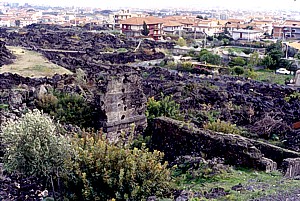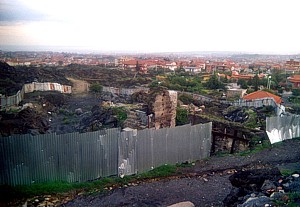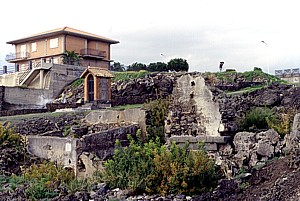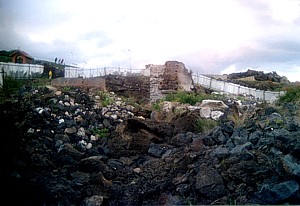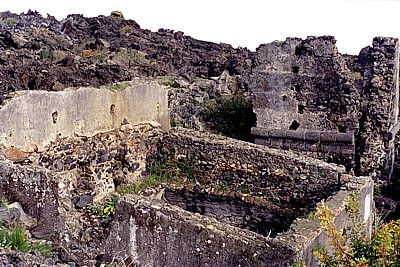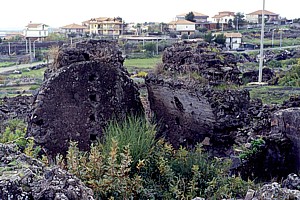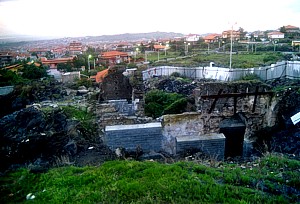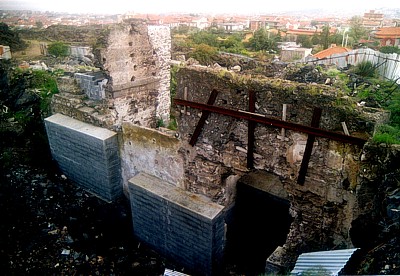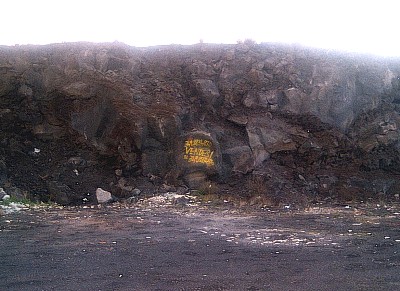| Etna
index |
||
| Geology | Geological history | Cones and craters |
| Eruptive characteristics | Eruptions before 1971 | Eruptions since 1971 |
| Etna and Man | References | Web sites |
| Weather forecasts | FAQ | Latest news |
Two
views of the same place, four years apart: this is what remains
of the cathedral of old Misterbianco, destroyed by the 1669 lava
flow, and once more by Man, between November 1999 (when the photograph
at left was taken) and October 2003 (right photograph). Known
only to very few people even in the Etna area, the site lies a
few kilometers to the north of the new (post-1669 eruption) Misterbianco
in an area affected by uncontrolled urbanization in recent years.
In 1999, the remainder of the cathedral tower rose from a small
patch of 1669 lava that had been saved from construction of private
homes, but four years later the scene had changed: a fence had
been placed around the site, and some restoration work had been
started on the ruin, but eventually the project was abandoned
and things were left as they were - for an undetermined time |
|
Etna
photo gallery: 2003
Return to Etna
![]()
Part 4: September-October 2003
Here we come to one of the saddest episodes of mismanagement of the Etnean territory and the local cultural and historical heritage. Saveguarding of the territory is not of highest priority to Sicilian policy-makers, and this is strongly reflected in the habits and behavior of the local population. Waste is dumped anywhere that is not someone's private property, most evident after the traditional family trips on Sundays or holidays into the nature, when garbage is found abundantly at all popular picnicking places. However, the example of "u' Campanarazzu" shows this attitude in a particularly overwhelming manner.
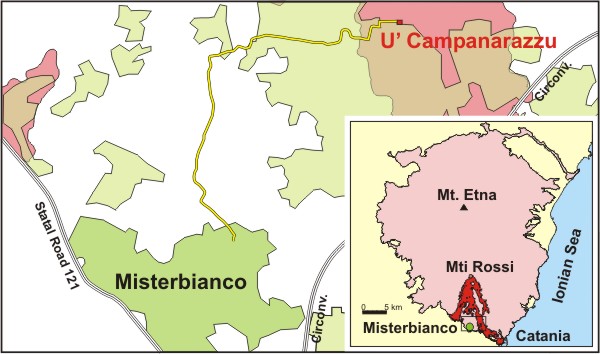 |
Location
map of the "Campanarazzu" at the southern base of Etna.
Inhabited areas are shown in green, and 1669 lava in pink color.
The road leading from the town of Misterbianco to "u' Campanarazzu"
is highlighted in yellow. The junction between the Catania-Messina
and Catania-Palermo highways is marked as "Circonv."
(circonvallazione). Inset shows outline of 1669 lava flow in red,
and box indicates area shown in main map |
"U'
Campanarazzu" (the church tower, in local dialect) is actually
what remains of the former town of Misterbianco, which was almost completely
buried by a branch of the enormous 1669 lava flow that was emitted from
the Monti Rossi eruptive center near Nicolosi, nearly 9 km away. The
site was (and still is) known to very few people except for those living
nearby, and even many Etna experts (scientists and non-scientists) have
never seen or heard of it. Until a few years ago, the scene was the
following: amidst an endless continuum of presumably mostly illegally
constructed homes there was a small remaining patch of 1669 lava, from
which in one place rose the stump of a church tower. This was what remained
of the cathedral of old Misterbianco, constituting an emblematic picture
of the effects of the devastating 1669 eruption. I visited (and, fortunately,
photographed) the site in November 1999, when there was full access
to the ruin and surrounding lava field. A small plate had been placed
on the side of the ruin, saying "Remains of ancient Misterbianco,
buried by the lava in March 1669. This commemorative tablet was placed
much later by the descendants in 19.." (exact date not readable).
Sometime between late 1999 and mid-2003, a fence (made of corrugated
iron sheets) was placed around the site, and some work was begun which
apparently was aimed at restoring the ruins and supporting unstable
portions of them. But this was made in a terribly careless manner. Concrete
- a substance dearly loved and used everywhere in Sicily - was applied
as one of the main components of the stabilizing structures. Then, at
an unknown time, the work was interrupted and the site was abandoned
for good, leaving the corrugated iron sheets to the action of wind and
vandalism. The entrance to the site was left open, so that everyone
(including children looking for a place to play) are free to enter and
risk their safety and health. Furthermore, the place has developed into
a kind of uncontrolled garbage dump. Although back in 1999 the scene
was not exactly suggestive due to the nearby presence of numerous recent
buildings (many of them being of debatable aesthetic value), the impressions
during the 2003 visit were simply depressing. What could be a site of
considerable historical and touristic value has been transformed in
a symbol of the feeble-mindedness of local policy-making and the careless
attitude of many of the local people toward their own historical and
natural heritage.
1999
(left) and 2003 (right) views of the "Campanarazzu" from
approximately the same direction. Note the small shrine in left
image, standing in front of a weekend (?) home. Same place four
years later shows the evidence of relentless political mismanagement
and indifference. Rather than improving the conditions, the attempt
of restoration of the site has led to a profound deterioration.
Some of the building remains around the old church tower have been
destroyed. The abandonment of the "restoration" work has
invited many people to use the place as a garbage dump |
|
Left:
the nave of the ancient cathedral of Misterbianco as it was in
1999. Right: destroyed in 1669 by the lava flow and again between
1999 and 2003, this time by Man, the ruin of the old cathedral
stands as a symbol of irreverence of local policy-makers and inhabitants
toward their own historical and natural heritage. Note the abundance
of private homes in the background in both photographs |
|
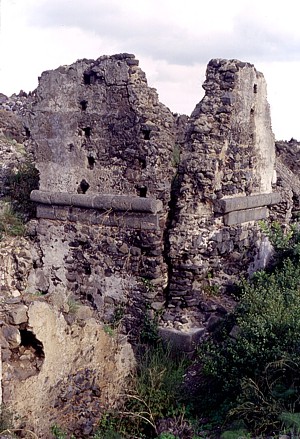 |
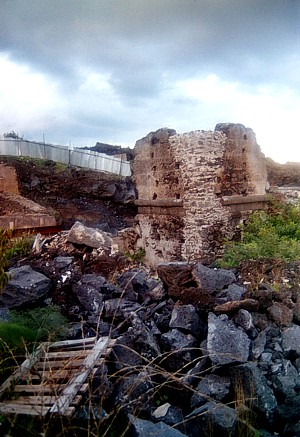 |
Two
more views of "u' Campanarazzu" showing the changes
made by the incompleted "restoration" action between
1999 (left) and 2003 (right) |
|
Return to the Etna photo gallery
Copyright © Boris Behncke, "Italy's Volcanoes: The Cradle of Volcanology"
Page set up on 29 January 2004, last modified on 31 January 2004

